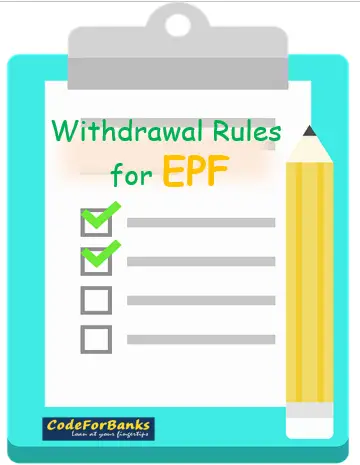Withdrawal Rules for EPF
By Anupama Deshpande | August 19, 2019



EPF account is opened by the employer for the benefit of the employees. It is considered a very good investment avenue for the following 3 reasons:
- Employer also contributes the equivalent amount (however 8.33% of the employer's contribution goes towards the Employees' Pension Scheme)
- It generates guaranteed returns. The Ministry of Labour and Employment decides the interest rate provided to members
- It is considered very safe investment for the purpose of retirement

EPFO has defined some Withdrawal Rules for EPF which you may be interested to know. The withdrawal rules for EPF have been outlined below:
- EPFO offers a facility to its members to claim their money from PF accounts online
- If withdrawal amount is less than Rs. 10 lakhs, it can be claimed either online or offline whichever suits you
- It is mandatory for all the members to file claims online if the withdrawal amount exceeds Rs. 10 Lakhs
- Apart from retirement, an employee can also make a claim for the final settlement of the EPF account if he leaves the job but only after 2 months of leaving the job
- Withdrawals are generally not allowed from your EPF account, unless you have quitted your job or have become self-employed or jobless or no longer in service
- You can apply for withdrawal by submitting following forms:
- Form 19: To withdraw funds from the EPF account for final settlement. It can be filled online as well as offline. For filling up it online, you need to first activate your UAN at the EPF member portal
- Form 10C: It is filled for withdrawal of pension
- Form 31: It is filled for withdrawing EPF partially
- Form 15G/ 15H: In case your service period is less than 5 years and PF withdrawal amount is more than Rs 50,000, there is a provision of deduct tax. If you want to save tax on PF withdrawal in such situations, you need to fill up form 15G/ 15H. Form 15G and Form 15H are declarations which can be submitted to receive payments without deduction of tax in case of members having total annual income of Rs. 2.50 lakhs and 3.00 lakhs respectively. Form 15H is applicable for Senior Citizens (60 years or older) whereas Form-15G is for everybody else. Also, a member must have a PAN before applying in these forms.
- PAN is also mandatory for claiming final settlement
- You have to get yur signature on Form 19 and get it attested by your former employer or your bank manager/ gazetted officer
- If you use "UAN based Form 19" then it can bypass the employer signature requirement, if the UAN is linked with the aadhaar card of the employee
- Total balance in your EPF account consists of your (employee's) contribution, your employer's contribution and accrued interest on the both
- EPF Withdrawal Rules before 5 years of Service: TDS is deducted on the withdrawal amountfor EPF withdrawal made before 5 years of continuous service. In case you want to withdraw your funds before 5 years of service but the withdrawal amount is less than Rs. 50,000, then TDS is not deducted
- An employee can withdraw upto 90% of total PF balance within 1 year before retirement or any time after attainment of the age of 54 years
- EPF withdrawal rules for illness: You are allowed to withdraw your (employee's) share with interest or 6 times the monthly salary, whichever is lower, from the EPF for the medical treatment purpose
- EPF withdrawal rules for marriage: You are allowed to withdraw up to 50% of your (employee's) contribution with interest from the EPF for the marriage purpose. You must have completed 7 years of service to opt for it
- EPF withdrawal rules for house purchase or epf withdrawal rules for home loan: You can withdraw up to 90% of the accumulated corpus of your EPF for purchase of house. You can avail this partial withdrawal facility only once in your life for housing purposes
- EPF withdrawal rules for home loan repayment: In case you want to withdraw from EPF for repayment of housing loan, you must have completed 10 years of service to opt for it
- EPF withdrawal rules for NRI: Employee who left the job because he is planning to settle abroad or he has got the job in a foreign country can withdraw full amount from EPF and waiting period of 2 months can be waived for such cases
- EPF withdrawal rules for Education: Employee can withdraw from EPF account for education of himself, his siblings or children. He can withdraw up to 50% of his own share with interest from the EPF account
Withdrawal Rules for EPS (Employees' Pension Scheme)
- You cannot claim for EPS withdrawal, if your cumulative service period is more than 10 years. In such a scenario, you will start receiving EPS pension on attaining an age of 58 years.
- You can claim for the EPS withdrawal, if your cumulative service period is less than or equal to 10 years. You can claim it any time by filling up form 10C. The claim can be made both online or offline. For applying through online mode, you need to use the UAN Member e-Sewa Portal.
Popular post 4 Reasons: Why Should You Extend PPF after its Maturity?
Share This :


About Anupama Deshpande
 Anupama is a Co-Founder of CodeForBanks.com. She is an MBA (Finance) and Chartered Financial Analyst (CFA). She also carries a Fellowship degree in Life Insurance Sector and is a Master of Computer Application (MCA). She is an expert in Finance Field with an experience of over 18 years on different managerial positions in finance industry including Stock Market, Depository and Mutual Fund Sectors. Apart from that she has remained for few years in the field of marketing as well. Her suggestions and advice for investments have been very useful to many people.
Anupama is a Co-Founder of CodeForBanks.com. She is an MBA (Finance) and Chartered Financial Analyst (CFA). She also carries a Fellowship degree in Life Insurance Sector and is a Master of Computer Application (MCA). She is an expert in Finance Field with an experience of over 18 years on different managerial positions in finance industry including Stock Market, Depository and Mutual Fund Sectors. Apart from that she has remained for few years in the field of marketing as well. Her suggestions and advice for investments have been very useful to many people.Her vast interest & expertise in the field of finance have encouraged her to write the articles so that others can also get benefitted out of them. She never loses any opportunity to learn and be creative. She is a valuable asset for CodeForBanks.com & important resource to all those around her.